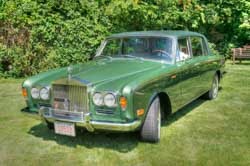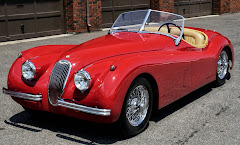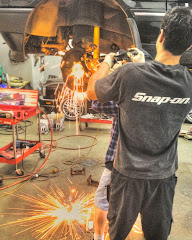I’ve been a tech inspector for track events for the Porsche
and Ferrari Clubs for the past 20 years.
Sometimes people ask what we require in a tech inspection, and how it
differs from Massachusetts state inspection.
In this essay I will show you.
The purpose of Tech Inspection is to make sure the car you
run on the track is safe. That’s really
our only concern. We don’t want you to
be a danger to yourself, and we don’t want to see you creating a hazard for
others. To that end, we focus on these
things:
We start by putting the car on a lift and checking tires,
wheels, brakes and suspension.
Some classes allow racing tires, and you may be changing
tires for the event. If so, we note that
on the form and someone will check your race tires at trackside.
We make sure the tires are free of cuts, bruises, and punctures. They can’t be visibly patches or damaged in
any way. If they are street tires they
must have legal (1/16) tread across the tire, and the date code must be less
than 6 years ago. The tires need to have
the proper rating for the capability of the car.
 |
| Sidewall and tread cracks are unsafe, and they won't pass no matter what the age |
The rims must appear round (no dents) and free of cracks or
damage.
If you are running the tires that the car comes to us with
we will torque the wheels in the shop.
 |
| We check for dents and damage, particularly inside the wheel rims |
 |
| Most track events call for street legal tread depth |
We look in at the brakes and suspension. Brake pads must be less than half worn (this
means the pad material must be noticeably thicker than the backing plate) with
no “low pad” lamp showing on the dash.
Brake rotors must be free of excessive ridges (that would mean they are
worn too thin) and they must be free of rust streaking (see the example of a
bad rotor) and finally if the rotors are drilled they may not have excessive
cracking. The photos below show a rotor
that is at the limit. This car will need
new brakes for subsequent events.
 |
| This brake rotor is showing cracks at the vent holes and some ridge at the edge. It''s ready to be replaced |
 |
| This rotor is unsafe on the track because the rust stripes reduce braking efficiency |
You need fresh brake fluid every year no matter what, and if
you run in the more aggressive classes you will need fresh fluid every so many
runs. We often flush fluid as part of
inspection. Some cars can be bled by
pressure or foot pumps while others require use of a tool to activate pumps.
Brake hoses must be less than 10 years old, unless the
carmaker specifies changing then sooner, in which case they need to be within
that limit. This car’s brake hoses are
obviously original. The next photo shows
a replacement hose for comparison – the difference is obvious.
 |
| An original brake hose |
 |
| These replacement lines stand out under the car |
We check for cracks and damage to the suspension arms. We look for loose ball and socket joints in
the suspension and steering, We check
for tears and wear in the bushings. No
broken boots on the steering or suspension joints.
Moving on, we check to make sure there is nothing loose or
in danger of falling off under the car.
You may enjoy the experience of shedding unwanted parts but the driver
behind you won’t see things so favorably.
We also look for leaks.
Seepage is ok, but we won’t pass a car that shows bulging water lines or
leaks at oil hose edges, because they could blow on the track. A cooling system blowout or oil line failure
could put the following cars into the guardrails in an instant.
Your throttle, brake, and clutch linkages must work smoothly
with no binds. Drive and axle shafts
must be tight with no broken or split boots.
Fuel lines and pipes must be correct and tight with no signs of cracking
or ageing.
We check the steering linkage to make sure everything is
tight. This includes the steering wheel
attachment, if yours is a quick release.
The outside body check is usually pretty quick. No cracked
or broken lights. Headlights and brake
lights have to work. No cracks in the
windshield. Wipers/washers have to be
working properly. Door latches must be
solid.
 |
| Lights must work, no cracks, and they must be tight. If they are glass, some class will require safety tape. These newer lights are plastic |
Inside the car we expect to seat correct seat belts for the
class – this may mean stock belts or competition harnesses. You may need a roll bar and the rules for
that vary. Note that it’s your
responsibility to make sure your car is fitted properly for its class.
We track inspectors mostly look at street interiors but we do see the occasional full-on race car like this Bentley GT3:
For a street car we expect a fire extinguisher with a current label and it
needs to be installed in a solid metal bracket.
The plastic brackets sold for home use are not safe as they can let go
on the track. A race car like the Bentley above would have a built in fire suppression system.
Some track forms ask us to certify that you showed us your helmet, and it had valid stickers inside. Others will inspect helmets at the track. We do not check your registration status, nor do we check
the status of your club registration or competition license. It’s your responsibility to manage those
things as you may be queried trackside.
We require an exhaust that conforms to street rules (if the car is
registered) or track rules (if it’s a track car) We do not test emissions for tech
inspections.
With all that we hope you can go to the track, have fun, and
stay safe.
John Elder Robison
 |
| A Bentley leads around the turn when the Pirelli GT Series came to Lime Rock in CT |
(c) 2017 John Elder Robison
John Elder Robison is the general manager of J E Robison Service Company, celebrating 30 years of independent Porsche, Ferrari, Bentley, BMW/MINI, Mercedes, Land Rover, and Rolls-Royce restoration and repair in Springfield, Massachusetts. John is a longtime technical consultant to the car clubs, and he’s owned and restored many fine British and German motorcars. Find him online at www.robisonservice.com or in the real world at 413-785-1665
Reading this article will make you smarter, especially when it comes to car stuff. So it's good for you. But don't take that too far - printing and eating it will probably make you sick.



































No comments:
Post a Comment